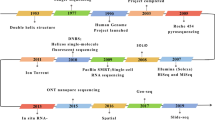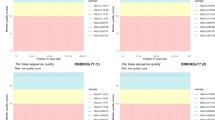Abstract
Cervical malignancy (CC) is the 2nd most prevalent malignancy among females, leading to cancer mortality. Primary detection of CC tumors results in an improved prognosis. CC is a malignant gynecological tumor, with few treatment options. New diagnostic and therapeutic agents are required to expand patient survival and quality of life. If CC tumors can be found at an early stage, the prognosis is much brighter. New diagnostic and therapeutic agents are needed to increase patient survival and quality of life. In this work, we performed whole-exome sequencing utilizing V5 (Illumina platform) 10 samples, 5 control and 5 CC tumour tissue, and we compared the results with transcriptome studies. KMT2C variations were shown to be among the most vicious in this analysis. From an Indian viewpoint, we found a plethora of SNVs and mutations, including those with known, unknown, and possible effects on health. Based on our findings, we know that the KMT2C gene is on chr. Seven and in exon 8, all three recognized variants are missense, synonymous, coding synonymous, non-coding variants, and GnomAD MAF (− 0.05). The variation at position (7:152265091, T > A, SNV 62478356) in KMT2C is unique, potent, and pathogenic. The missense coding transcript CIQTNF maps to chromosome 7 and displays T > C SNV. In addition, we performed single strand conformational polymorphism analysis on 64 samples and further confirmed them using Sanger sequencing to understand and verify the mutations. KMT2C shows a log FC value of − 1.16. Understanding emerging harmful mutations from an Indian viewpoint is facilitated by our bioinformatics-based, extensive correlation studies of WES analysis. Potentially harmful and new mutations were found in our preliminary analysis; among these ten top mutated genes, KMT2C and CIQTNF were altered in ten cases of CC with an Indian phenotype.


















Similar content being viewed by others
Data Availability
All raw reads are available through NCBI-SRA PRJNA Bio project submission: SUB10812780. The microarray data has been deposited in the GEO database under accession number GSE127265 (https://www.ncbi.nlm.nih.gov/geo/query/acc.cgi?acc=GSE127265). If you have any inquiries, please contact the respective author.
Abbreviations
- CC:
-
Cervical Cancer
- AHG:
-
Affymetrix human genome
- CSCC:
-
Cervical squamous cell carcinoma
- GEO:
-
Gene expression Omnibus
- TCGA:
-
Cancer Genome Atlas
- WES:
-
Whole exome sequencing
- FDR:
-
False discovery rate
- NGS:
-
Next generation sequencing
- AGCC:
-
Affymetrix GeneChip® Command Console
- KM:
-
Kaplan–Mayer
- AEC:
-
Affymetrix expression console
- FFPE:
-
Formalin-fixed paraffin-embedded
- TAC:
-
Transcriptome analysis console
- HCD:
-
Human Clariom D
References
Sung H, Ferlay J, Siegel RL, Laversanne M, Soerjomataram I, Jemal A, Bray F (2021) Global cancer statistics 2020: GLOBOCAN estimates of incidence and mortality worldwide for 36 cancers in 185 countries. CA Cancer J Clin 71:209–249. https://doi.org/10.3322/caac.21660
Gupta R, Srinivasan R, Nijhawan R, Suri V, Uppal R (2010) Protein p16INK4A expression in cervical intraepithelial neoplasia and invasive squamous cell carcinoma of uterine cervix. Indian J Pathol Microbiol 53:7–11. https://doi.org/10.4103/0377-4929.59174
Poondla N, Madduru D, Duppala SK, Velpula S, Nunia V, Kharb S, Ghatak S, Mishra AK, Vuree S, Neyaz MK, Suravajhala P (2021) Cervical cancer in the era of precision medicine: a perspective from developing countries. Adv Cancer Biol Metastas 3:100015. https://doi.org/10.1016/j.adcanc.2021.100015
Piñeros M, Saraiya M, Baussano I, Bonjour M, Chao A, Bray F (2021) The role and utility of population-based cancer registries in cervical cancer surveillance and control. Prev Med 144:106237. https://doi.org/10.1016/j.ypmed.2020.106237
Arbyn M, Weiderpass E, Bruni L, de Sanjosé S, Saraiya M, Ferlay J, Bray F (2020) Estimates of incidence and mortality of cervical cancer in 2018: a worldwide analysis. Lancet Glob Health 8:e191-203. https://doi.org/10.1016/S2214-109X(19)30482-6
Chan CK, Aimagambetova G, Ukybassova T, Kongrtay K, Azizan A (2019) Human papillomavirus infection and cervical cancer: epidemiology, screening, and vaccination—review of current perspectives. J Oncol. https://doi.org/10.1155/2019/3257939
Cohen PA, Jhingran A, Oaknin A, Denny L (2019) Cervical cancer. Lancet 393:169–182. https://doi.org/10.1016/S0140-6736(18)32470-X
Wang YX, Arvizu M, Rich-Edwards JW, Stuart JJ, Manson JE, Missmer SA, Pan A, Chavarro JE (2020) Menstrual cycle regularity and length across the reproductive lifespan and risk of premature mortality: prospective cohort study. BMJ. https://doi.org/10.1136/bmj.m3464
Meena N, Mathur P, Medicherla KM, Suravajhala P (2018) A bioinformatics pipeline for whole exome sequencing: overview of the processing and steps from raw data to downstream analysis. Bio Protocol. https://doi.org/10.21769/BioProtoc.2805
Saslow D, Runowicz CD, Solomon D, Moscicki AB, Smith RA, Eyre HJ, Cohen C (2002) American cancer society guideline for the early detection of cervical neoplasia and cancer. CA Cancer J Clin 52:342–362. https://doi.org/10.3322/CANJCLIN.52.6.342
Katz Y, Wang ET, Silterra J, Schwartz S, Wong B, Thorvaldsdottir H, Robinson JT, Mesirov JP, Airoldi EM, Burge CB (2015) Quantitative visualization of alternative exon expression from RNA-seq data. Bioinformatics 31:2400–2402. https://doi.org/10.1093/bioinformatics/btv034
Thorvaldsdóttir H, Robinson JT, Mesirov JP (2013) Integrative genomics viewer (IGV): high-performance genomics data visualization and exploration. Brief Bioinform 14:178–192. https://doi.org/10.1093/bib/bbs017
Scholl S, Popovic M, de La Rochefordiere A, Girard E, Dureau S, Mandic A, Koprivsek K, Samet N, Craina M, Margan M, Samuels S (2019) Clinical and genetic landscape of treatment naive cervical cancer: alterations in PIK3CA and in epigenetic modulators associated with sub-optimal outcome. EBioMedicine 43:253–260. https://doi.org/10.1016/j.ebiom.2019.03.069
Sd A, Pasumarthi D, Pasha A, Doneti R, Botlagunta M, Pawar SC (2021) Identification of differentially expressed genes in cervical cancer patients by comparative transcriptome analysis. BioMed Res Int. https://doi.org/10.1155/2021/8810074
Wheeler DL, Chappey C, Lash AE, Leipe DD, Madden TL, Schuler GD, Tatusova TA, Rapp BA (2000) Database resources of the national center for biotechnology information. Nucleic Acid Res 28:10–14. https://doi.org/10.1093/nar/28.1.10
Li T, Fan J, Wang B, Traugh N, Chen Q, Liu JS, Li B, Liu XS (2017) TIMER: a web server for comprehensive analysis of tumor-infiltrating immune cells. Cancer Res 77:e108–e110. https://doi.org/10.1158/0008-5472.CAN-17-0307/SUPPLEMENTARY-VIDEO-S1
Li T, Fu J, Zeng Z, Cohen D, Li J, Chen Q, Li B, Liu XS (2020) TIMER2. 0 for analysis of tumor-infiltrating immune cells. Nucleic Acid Res 48:W509–W514. https://doi.org/10.1093/NAR/GKAA407
Goel MK, Khanna P, Kishore J (2010) Understanding survival analysis: Kaplan-Meier estimate. Int J Ayurveda Res 1:274. https://doi.org/10.4103/0974-7788.76794
Nagy Á, Lánczky A, Menyhárt O, Győrffy B (2018) Validation of miRNA prognostic power in hepatocellular carcinoma using expression data of independent datasets. Sci Rep 8:9227. https://doi.org/10.1038/s41598-018-29514-3
Nagy Á, Lánczky A, Menyhárt O, Győrffy B (2018) Validation of miRNA prognostic power in hepatocellular carcinoma using expression data of independent datasets. Sci Rep 8:9227. https://doi.org/10.1038/S41598-018-27521-Y
Kanehisa M, Furumichi M, Tanabe M, Sato Y, Morishima K (2017) KEGG: new perspectives on genomes, pathways, diseases and drugs. Nucleic Acid Res 45:D353–D361. https://doi.org/10.1093/NAR/GKW1092
Kanehisa M, Goto S (2000) KEGG: kyoto encyclopedia of genes and genomes. Nucleic Acid Res 28:27–30. https://doi.org/10.1093/NAR/28.1.27
Szklarczyk D, Gable AL, Nastou KC, Lyon D, Kirsch R, Pyysalo S, Doncheva NT, Legeay M, Fang T, Bork P, Jensen LJ (2021) The STRING database in 2021: customizable protein–protein networks, and functional characterization of user-uploaded gene/measurement sets. Nucleic Acid Res 49:D605–D612. https://doi.org/10.1093/NAR/GKAA1074
Mering CV, Huynen M, Jaeggi D, Schmidt S, Bork P, Snel B (2003) STRING: a database of predicted functional associations between proteins. Nucleic Acid Res 31:258–261. https://doi.org/10.1093/nar/gkg034
Ozsolak F, Milos PM (2011) RNA sequencing: advances, challenges and opportunities (2011). Nat Rev Genet 12:87–98. https://doi.org/10.1038/NRG2934
Wang Z, Gerstein M, Snyder M (2009) RNA-Seq: a revolutionary tool for transcriptomics. Nat Rev Genet 10:57–63. https://doi.org/10.1038/NRG2484
Stephens PJ, Tarpey PS, Davies H, Van Loo P, Greenman C, Wedge DC, Nik-Zainal S, Martin S, Varela I, Bignell GR, Yates LR (2012) The landscape of cancer genes and mutational processes in breast cancer. Nature 486:400–404. https://doi.org/10.1038/NATURE11017
Wu YA, Wang X, Wu F, Huang R, Xue F, Liang G, Tao M, Cai P, Huang Y (2012) Transcriptome profiling of the cancer, adjacent non-tumor and distant normal tissues from a colorectal cancer patient by deep sequencing. https://doi.org/10.1371/JOURNAL.PONE.0041001
Poleboyina PK, Rampogu S, Doneti R, Pasha A, Poleboyina SM, Bhanothu S, Pasumarthi D, SD A, Kumbhakar D, Lee KW, Pawar SC (2022) Screening and identification of potential inos inhibitors to curtail cervical cancer progression: an in silico drug repurposing approach. Appl Biochem Biotechnol. https://doi.org/10.1007/s12010-021-03718-2
Yi M, Tang Y, Liu B, Li Q, Zhou X, Yu S, Fu S, Cai Y, Yuan X (2016) Genetic variants in the ITGB6 gene is associated with the risk of radiation pneumonitis in lung cancer patients treated with thoracic radiation therapy. Tumor Biol 37:3469–3477. https://doi.org/10.1007/S13277-015-4171-Y
Tamrakar VK, Parihar NS, Bhat J, Rajasubramaniam S (2023) Strengthening the diagnosis of drug-resistant tuberculosis using ngs-based approaches and bioinformatics pipelines for data analysis in India. Indian J Microbiol. https://doi.org/10.1007/s12088-023-01134-0
De Cario R, Kura A, Suraci S, Magi A, Volta A, Marcucci R, Gori AM, Pepe G, Giusti B, Sticchi E (2020) Sanger validation of high-throughput sequencing in genetic diagnosis: still the best practice? Front Genetics 11:592588
Deepti P, Pasha A, Kumbhakar DV, Doneti R, Heena SK, Bhanoth S, Poleboyina PK, Yadala R, Annapurna SD, Pawar SC (2022) Overexpression of secreted phosphoprotein 1 (SPP1) predicts poor survival in HPV positive cervical cancer. Gene 824:146381. https://doi.org/10.1016/J.GENE.2022.146381
Nesakumar M, Luke EH, Vetrivel U (2023) Next-gen dual transcriptomics for adult extrapulmonary tuberculosis biomarkers and host-pathogen interplay in human cells: a strategic review. Indian J Microbiol. https://doi.org/10.1007/s12088-023-01143-z
Faundes V, Newman WG, Bernardini L, Canham N, Clayton-Smith J, Dallapiccola B, Davies SJ, Demos MK, Goldman A, Gill H, Horton R (2018) Histone lysine methylases and demethylases in the landscape of human developmental disorders. Am J Hum Genetic 102:175–187. https://doi.org/10.1016/j.ajhg.2017.11.013
Mann M, Kumar S, Chauhan SS, Bhatla N, Kumar S, Bakhshi S, Gupta R, Sharma A, Kumar L (2019) Correction: PARP-1 inhibitor modulate β-catenin signaling to enhance cisplatin sensitivity in cancer cervix. Oncotarget 10:4802. https://doi.org/10.18632/oncotarget.27101
Sujitha S, Vishnu US, Karthikeyan R, Sankarasubramanian J, Gunasekaran P, Rajendhran J (2019) Genome investigation of a cariogenic pathogen with implications in cardiovascular diseases. Indian J Microbiol 59:451–459. https://doi.org/10.1007/s12088-019-00823-z
Acknowledgements
We gratefully acknowledge the support from MNJ Hospital, Hyderabad, for the ethical committee towards kind assistance of tissue sampling. We sincerely acknowledge SCP for her support. We are greatly indebted to Bioclues.org and its founder, PS, for his valuable time and energy in helping with data analysis and editing the complete manuscript preparations. We gratefully acknowledge the resources provided by BISR, Jaipur, Rajasthan. We specially acknowledge Dr. Ashwani Kumari, DNA Xperts Ashwani for performing Whole Exome Sequencing and clearing all our queries. We thank the Department of Genetics and Biotechnology, Osmania University, Hyderabad, School of Bioengineering and Biosciences, Lovely Professional University, Jalandhar, Punjab, and GenepoweRx (K&H Personalized Medicine Clinic), Hyderabad, Telangana, India for their support and encouragement.
Funding
Prof. Smita C. Pawar received funds supporting this project from the Science and Engineering Research Board (SERB), India (EEQ/ 2019/000569), on January 6, 2020.
Author information
Authors and Affiliations
Contributions
Sugunakar Vuree (SGV), Smita C. Pawar (SCP) and Prashanth Suravajhala (PS) conceived the idea. Santosh Kumari Duppala (SKD)is the first author who wrote the manuscript and performed analysis. SKD, SGV and PS analysed the data and interpreted the whole manuscript. Pavan Kumar Poleboyina (PKB), Bhumandeep Kour (BK), Ashish Vyas (AV), and Govardhan Bale (GB) performed lateral analyses. PS and SGV critically reviewed and proofread the manuscript. All the authors have read and approved the final version of the manuscript.
Corresponding authors
Ethics declarations
Conflict of interest
The authors didn’t have any competing interests.
Ethical Approval
All the institutional guidelines and ethical clearance are carried out from MNJ Hospital Hyderabad Telangana (Regd No: ECR/227/Inst/AP/2013/RR-19) with an approval date of 20 Jan 2020.
Additional information
Publisher's Note
Springer Nature remains neutral with regard to jurisdictional claims in published maps and institutional affiliations.
Rights and permissions
Springer Nature or its licensor (e.g. a society or other partner) holds exclusive rights to this article under a publishing agreement with the author(s) or other rightsholder(s); author self-archiving of the accepted manuscript version of this article is solely governed by the terms of such publishing agreement and applicable law.
About this article
Cite this article
Duppala, S.K., Poleboyina, P.K., Kour, B. et al. A Pilot Study Based on the Correlation Between Whole Exome and Transcriptome Reveals Potent Variants in the Indian Population of Cervical Cancer. Indian J Microbiol (2024). https://doi.org/10.1007/s12088-024-01295-6
Received:
Accepted:
Published:
DOI: https://doi.org/10.1007/s12088-024-01295-6




